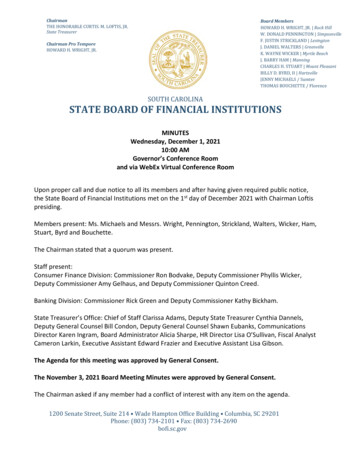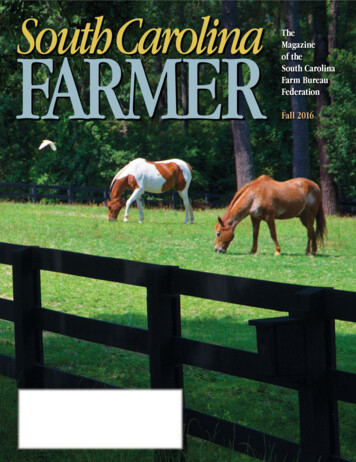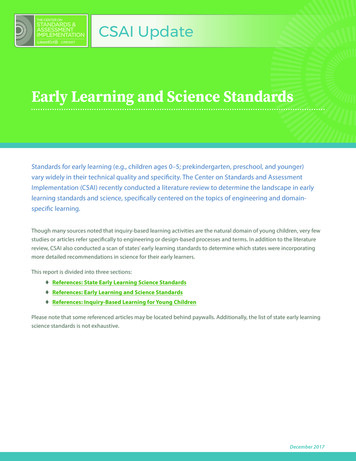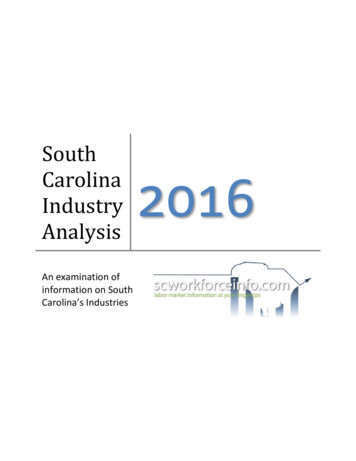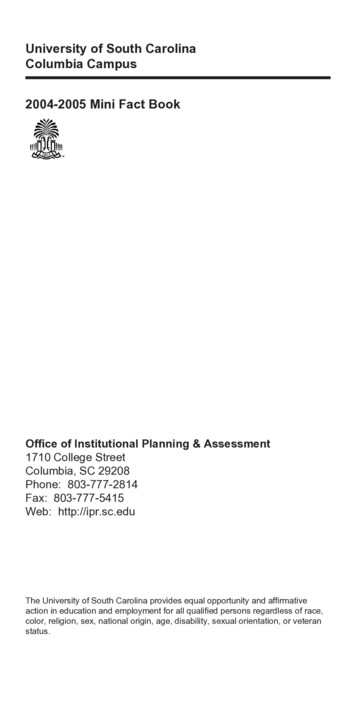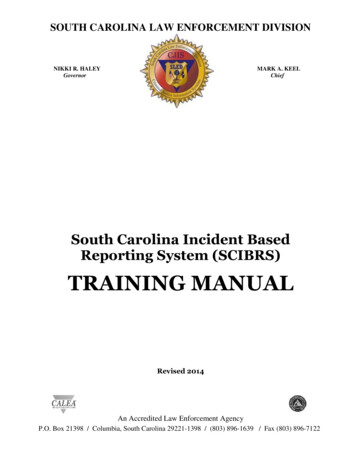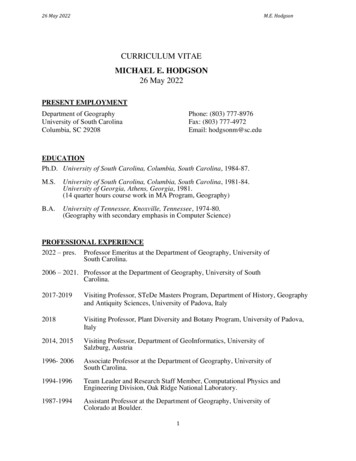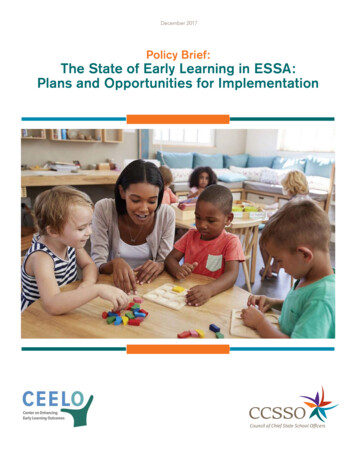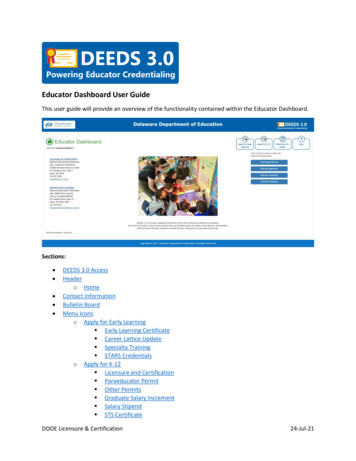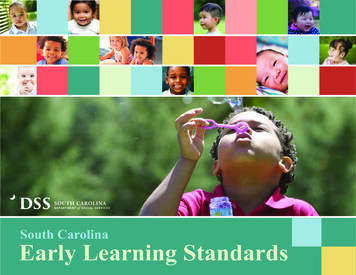
Transcription
South CarolinaEarly Learning Standards
TABLE OF CONTENTSSouth Carolina Early Learning StandardsRskdhf;aoidfha3
NATIONAL EXPERT CONSULTANTSIn 2013, the South Carolina State Child Care Administrator’sOffice, the Division of Early Care and Education housed withinthe SC Department of Social Services (SCDSS), authorized andfunded the revision of the Infant-Toddler Guidelines and the GoodStart, Grow Smart Early Learning Standards to create the SouthCarolina Early Learning Standards (ELS)—a single documentthat describes children’s development and learning from birth toage five. The Division of Early Care and Education and the Officeof Literacy and Early Learning in the South Carolina Departmentof Education (SCDE) provided co-leadership for this initiativeand have contributed critical advice, oversight, and vision on theELS and its implementation. As listed below, many individualsfrom across the state devoted their time and expertise to thistask force. We are grateful to everyone’s work on this importantresource for our state.Sharon Lynn KaganVirginia and Leonard Marx Professor of Early Childhood andFamily Policy Teacher’s College, Columbia UniversityThese standards are based on the North Carolina Foundationsfor Early Learning and Development. We thank the North CarolinaDivision of Child Development and Early Education and the NorthCarolina Department of Public Instruction for granting SouthCarolina permission to rely heavily on the work of its neighbor tothe north in the development of this resource.These South Carolina Standards are different from the NorthCarolina Foundations for Early Learning and Development inthat they include Mathematical Thinking and Expression asa separate domain. Thank you to Mary Ruzga, MathematicsEducation Associate, from the Office of Standards and Learningat the SCDE and Sandra Linder, Associate Professor of EarlyMathematics at Clemson University for guidance in the mathdomain.This publication is dedicated to South Carolina’s early childhoodprofessionals and the teachers who nurture and support thedevelopment of many young children who are in school or whiletheir families work.Catherine Scott-LittleAssociate Professor of Human Development and FamilyStudies University of North Carolina at GreensboroSOUTH CAROLINA EARLY LEARNINGSTANDARDS EXECUTIVE COMMITTEEJennifer AndersonDirector, Office of Early Learning and LiteracySouth Carolina State Department of EducationAngela BaumAssociate Professor of Early Childhood EducationUniversity of South CarolinaPenny Danielson, ELS Revision Co-ChairTeam Lead, Child Development Educational ProgramSouth Carolina State Department of EducationNancy Freeman, Co-writerProfessor EmeritaUniversity of South CarolinaBeverly Hunter, Project ManagerProgram Manager, ABC Quality Rating and ImprovementSystem Division of Early Care and Education, SCDSSNoelle McInerney, ELS Revision Co-ChairProgram and Policy Lead, Division of Early Care and EducationSouth Carolina Department of Social ServicesSouth Carolina Early Learning StandardsACKNOWLEDGEMENTS4
Also serve as a members of the Leadership Team andStakeholder GroupPUBLIC COMMENTOpportunities for public comment on the South Carolina EarlyLearning Standards (SC-ELS) were provided from May 6, 2016to May 22, 2016; September 9, 2016 to October 10, 2016;and from February 1, 2017 to February 15, 2017. Feedbackwas received from over 200 individuals including teachers ofinfants, toddlers, and 2-year olds; 3K, 4K, and 5K teachersfrom public and private settings; teachers of children in grades1-4; Head Start administrators; public school and districtlevel administrators; directors of child care programs; literacy,instructional, and reading coaches; higher education facultymembers; and parents and grandparents of young children.developed in 2006 with early learning standards for childrenthree to five years of age. In 2008, the South Carolina Infant& Toddler Guidelines were developed for children from birthto age three as a separate document. Both documentshave provided direction and guidance to the field towarddevelopmentally appropriate expectations that support younglearners.In 2013, the South Carolina Department of Social Services,which administers the state’s Child Care Development BlockGrant (CCDBG), took the lead to engage national earlychildhood and standards experts, Dr. Catherine Scott-Littleand Dr. Sharon Lynn Kagan to complete an in-depth researchanalysis of the state’s current early learning standards. Fromthis analysis, their recommendations provided the foundationas work on the revisions began with stakeholders acrosssectors providing input. The standards workgroup conducteda comprehensive review of many other states revised earlylearning standards. This review shaped the conversations andthe work on the standards revisions. The S.C. Stakeholderscame to an agreement on the following priorities for the newstandards: UNDERSTANDING THE SOUTH CAROLINAEARLY LEARNING STANDARDSHistoryIn the early 2000s, a White House initiative, Good Start,Grow Smart, called for each state to establish early learningguidelines with the goal of guiding early childhood educatorsin implementing classroom practices that facilitate thedevelopment of dispositions of young children and their learningof essential skills needed to be prepared for Kindergarten.The South Carolina Good Start, Grow Smart Guidelines were The standards would be revised as one document toshow the continuum of development from birth up to 5Kschool entry and would be organized using age groups likethose found in SC’s previous standards (B-8 months, 6-18months, 16-36 months, 36-48 months, 48-60 months, andPreparing for Kindergarten).The standards would be based on a balance of developmentally appropriate practices and age-appropriate rigorThe standards would take into consideration the needs anddevelopment of ALL children.The standards must provide exemplars that are clearand easy for South Carolina’s early childhood teachers tounderstand.The standards must address physical, social/emotional,South Carolina Early Learning StandardsMeir Muller, Lead WriterClinical Assistant Professor of Early Childhood EducationUniversity of South CarolinaPrincipal, Cutler Jewish Day School5
learning through play, literacy, math, and cognitivedevelopment (science and social studies) domains.The standards must be culturally relevant for the childrenand families of South Carolina.Children’s experiences before they enter school matter.Research shows that children who experience high-qualitycare and education, and who enter school well-prepared, aremore successful in school and later in their lives. Recognizingthe importance of the early childhood period, advocates in theSouth Carolina Department of Health and Human Servicescreated the ABC Child Care Program in 1992. The ABCChild Care Program established initial criteria used to definequality programming in early care and education settings. Theestablishment of this program was critical to advancing thequality of services provided to young children by establishingstandards for the professional development of teachers servingchildren birth through 5 years old.The State of South Carolina made a commitment to theearly years by funding universal, full-day kindergarten for allfive-year-olds more than twenty years ago. In 2006, SouthCarolina’s General Assembly made a significant investment infull-day 4K (pre-kindergarten) for children from communitieswith high levels of poverty in the Plaintiff and Trial districts. Thisfull-day 4K program, Child Development Education Program(CDEP), has since been expanded to fund sixty-one out of thestate’s eighty-two school districts in both public schools andapproved childcare centers. Participating CDEP programs mustadhere to high quality standards.In 2008, building on the early childhood initiatives cited above,the state modified the ABC Child Care Program to becomeABC Quality: South Carolina’s Quality Rating and ImprovementSystem (QRIS). The QRIS provides a system of supportsand services to build the capacity of early care and educationproviders to offer quality programming. Currently, enrolledearly childhood programs across the state serve infants upto preschoolers in a variety of different settings and sectorsincluding public schools, private childcare centers, faith-basedSouth Carolina Early Learning StandardsWith these six priorities guiding their work, the SC-ELSworkgroup continued with the challenging project of writing anddeveloping a new set of early learning standards. Progress wasmade, but at a slower pace than expected. The goal to havethe new set of ELS ready for the early childhood field by thespring of 2016 led to the decision to move the process forwardmore quickly by adapting a set of standards based on onestate’s standards that most closely met our goals. Our nationalexperts recommended four states to consider, and after a reviewprocess, it was decided to base our standards on the NorthCarolina Foundations for Early Learning and Development. TheNorth Carolina’s Early Childhood Advisory Committee (ECAC),Division of Child Development and Early Education (DCDEE),and Department of Public Instruction Office of Early Learningworked together to develop Foundations to provide a resource forall programs in their state. The developers of the North CarolinaFoundations for Early Learning and Development, the Divisionof Child Development and Early Education in the North CarolinaDepartment of Health and Human Services and the Officeof Early Learning in the North Carolina Department of PublicInstruction most graciously granted South Carolina permissionto base the South Carolina Early Learning Standards on theirdocument. The South Carolina Early Learning Standardsworkgroup created one new domain, Mathematical Thinkingand Expression (MTE), and made other revisions to the NorthCarolina Foundations document based on input from SouthCarolina early childhood stakeholders to insure the standardsare relevant to South Carolina and that they reflect the culturaldiversity found among our state’s children and teachers. Wehave included these agencies in our acknowledgements. Thepioneering work of North Carolina is greatly appreciated.INTRODUCTION6
This document, South Carolina’s Early Learning Standards(referred to as SC-ELS), serves as the shared vision for whatwe want for our state’s children, and answers the question“What foundational skills do children need to experiencesuccess in school?” By providing this common set of Goalsand Developmental Indicators for children from birth throughkindergarten entry, our hope is that family members, educators,administrators, and policy makers together can do the bestjob possible to provide experiences that help children be wellprepared for success in school and life.PURPOSE OF THE SOUTH CAROLINA EARLYLEARNING STANDARDSSouth Carolina’s Division of Early Care and Education, inthe Department of Social Services, and the Department ofEducation’s Office of Early Learning and Literacy workedtogether to develop the SC-ELS which describe Goals foryoung children’s development and learning. The SC-ELSis a resource for all programs serving young children inSouth Carolina. The SC-ELS provide support for teachers inserving children from all cultural and linguistic backgroundsand with children with divergent learning needs. Teachersand caregivers can turn to the SC-ELS to learn about childdevelopment as the document provides age-appropriate Goalsand Developmental Indicators for each age level—infant,toddler, and preschooler. The SC-ELS document is intended tobe a guide for teaching. This document is not a curriculum orchecklist that should be used to assess children’s developmentand learning. Rather, this document serves as a resource todefine the skills and abilities needed to support the learningexperiences provided for children. Teachers, caregivers, earlyInterventionists, home visitors, and other professionals whosupport and promote children’s development and learningcan use the Goals for children. It is, however, important toremember that while the SC-ELS can help determine whatis “typical” for children in an age group, the DevelopmentalIndicators may not always describe a child’s development.When a child’s development and learning does not seem tofit what is included in the continuum under his/her age level,teachers and caregivers should look at the DevelopmentalIndicators for younger or older age groups to see if thoseindicators align with the child’s development. The objectiveshould be to learn what developmental steps the child is takingnow and to meet the individual needs of that child daily.The ABC Quality Rating and Improvement System has “crosswalked” and revised its program and classroom standards withthe SC-ELS to assure consistency between the SC-ELS andthe ABC quality standards.The SC-ELS serves as a resource for families. Families mayfind it helpful to review the Goals and Developmental Indicatorsto learn what are appropriate goals for young children.SOUTH CAROLINA EARLY LEARNINGSTANDARDS CAN BE USED TO: Improve teachers’ knowledge of child development andincorporate each family’s culture;Guide teachers’ plans for implementing curricula;Establish goals for children’s development and learning thatare shared across programs and services; andInform family members and the public on age-appropriateexpectations for children’s development and learning.South Carolina Early Learning Standardschild care, family child care homes, and Head Start programs.Although the settings and approaches may be different, theseprograms and initiatives are all able to participate in the state’srating system and share a similar goal—to promote betteroutcomes for South Carolina’s young children.7
Training and technical assistance providers should evaluatethe support they provide to teachers and caregivers to ensurethat the professional development is consistent with the SCELS Goals and Developmental Indicators. Furthermore, highereducation institutionsmay use this documentas a tool or trainingA NOTE ABOUTmanual for in-serviceTERMINOLOGYprofessional development.In summary, the SouthThe South Carolina Early LearnCarolina Early Learninging Standards document is deStandards document issigned to be useful to a broaddesigned to be a resourcerange of professionals who workfor teachers, caregivers,with children. The terms “teachfamilies, administrators,ers and caregivers” refer to anyand professionalone who works directly with childevelopment providersdren—teachers, caregivers, earlyas we work together toeducators, early Interventionists,support the learning andhome visitors, etc. The docudevelopment of Southment also refers to “children”Carolina’s youngestgenerically, which is intendedchildren.to include infants, toddlers, andpreschool children.ORGANIZATION OF THIS DOCUMENTThis document begins with an Introduction, which providesbackground information on the use of the SC-ELS. Followingthe introduction, the SC-ELS Goals and DevelopmentalIndicators describe expectations for what children will learn,starting with infancy and covering all ages through kindergartenentry.The Goals and Developmental Indicators are divided into sixdomains: Approaches to Play and Learning (APL) Emotional and Social Development (ESD) Health and Physical Development (HPD) Language Development and Communication (LDC) Mathematical Thinking and Expression (MTE) Cognitive Development (CD)All six of the domains are essential components in the SCELS because all children develop differently. All domains areequally important and overlap is to be expected. The overlapis needed because children’s development and learning areintegrated or interrelated. The progress that a child makes inone domain is related to the progress he or she makes in otherdomains. For example, as a child interacts with adults (i.e.,Social Development), she/he learns new words (i.e., LanguageDevelopment) that helps her/him understand new concepts (i.e.,Cognitive Development). Therefore, it is essential that the SCELS address all six domains, and that teachers and caregiverswho use the SC-ELS realize that all six domains are related andshould not be considered independently from one another.A Domain Introduction is located at the beginning of eachdomain section. The introduction describes some of themost important ideas related to the domain. This introductoryinformation provides understanding of children’s learning anddevelopment. The introduction is followed by the Goal andSouth Carolina Early Learning StandardsFinally, the SC-ELS may serve as a beneficial tool for individualswho do not work directly with children, but who supportteachers and caregivers in their work. These individuals mayinclude those who work at museums, gardens, zoos, andother community destinations children may visit on field trips.It is important to take stock to see if a program’s learningenvironment, teaching materials, learning activities, andinteractions are supporting children’s development in the areasdescribed in this document. Administrators can use SC-ELS asa guide to evaluate the types of learning experiences providedin their program. The SC-ELS can also be a resource to identifyareas where teachers and caregivers need to improve theirpractices, and as a basis for professional development.8
DEVELOPMENTAL INDICATOR CONTINUUMGenerally, the Developmental Indicators describe expectationsthat many children will reach toward the end of their respectiveage level. They are not, however, hard and fast requirementsor expectations for what children should be able to do at theend of the age level. The fact that there is some overlap acrossthe age levels shows that what children know and can do atone age is closely related to what they know and can do at theprevious and the next age level. Most children will reach many,but not necessarily all, of the Developmental Indicators that arelisted for their age level; some will exceed the DevelopmentalIndicators for their age level well before they are chronologicallyat the upper end of the age range; and others may never exhibitskills and knowledge described for an age level. The Goaland Developmental Indicator Continuum are designed to helpteachers and caregivers identify where an individual child mightbe on the learning continuum described in the DevelopmentalIndicators, and to easily see what might have come before andwhat might come after the child’s current level of development.In limited instances, developmental indicators can be observedmore broadly in multiple age levels. When this occurs, an arrowis used to show that the developmental indicator occurs acrossmultiple age levels.The Developmental Indicators are numbered so that it iseasier to findspecific items. TheAGE PERIODSnumbering systemis the same for allThe Developmental Indicators areDevelopmentaldivided into overlapping age levelsIndicators acrossshown below. These age ranges helpall six domains.to know where to start when usingFirst, there is anthe Developmental Indicators. Theseabbreviation of theindicators describe expectations manydomain where thechildren will reach toward the end ofDevelopmentalthe respective age level, but are notIndicator isrequirements for what children shouldfound (APL forknow and can do at the end of the ageApproaches to Playperiod.and Learning inthe sample chart).Infants: birth to 12 monthsThe abbreviationYounger Toddlers: 8 to 21 monthsis followed byOlder Toddlers: 18 to 36 monthsa number thatYounger Preschoolers: 36 to 48 monthsindicates what GoalOlder Preschoolers: 48 to 60 monthsthe DevelopmentalIndicator isassociatedwith (1 for Goal 1 in the sample chart). Finally, each of theDevelopmental Indicators for each Goal has a letter that reflectsthe order of the item. The first indicator in the infant age levelbegins with the letter “a,” the second indicator begins with theletter “b,” etc. All subsequent indicators are assigned a letterin alphabetical order. (The sample chart shows DevelopmentalIndicators “a” through “p”). The numbering system is simply away to help teachers and caregivers communicate more easilyabout the Developmental Indicators (i.e., so they can referSouth Carolina Early Learning StandardsDevelopmental Indicator Continuum (sometimes called a“Continuum” in this document) for each domain. The Continuumfor each domain shows the Goals (statements that describea general area or aspect of development that children makeprogress on from birth through age five) for the domain, andthe Developmental Indicators (more specific statementsof expectations for children’s learning and development thatare tied to age levels). As the sample below shows, SouthCarolina has elected to arrange the Developmental Indicatorsalong a continuum so that the Developmental Indicators for theage levels from birth to kindergarten entry are included. Thisformat allows teachers and caregivers to easily look acrossthe age levels to see the progression that a child might maketoward the Goal. The Goals are organized in Subdomains orsubtopics that fall within the domain, with one or more Goal andDevelopmental Indicator Continua for each subdomain.9
Domain refersto the broad area oflearning or developmentthat is being addressedApproaches to Play and Learning (APL)Goal andDevelopmental Indicator Continuum is thechart that shows the Goaland corresponding Developmental Indicators for eachage levelSubdomain: Curiosity, Information-Seeking, and EagernessGoal APL-1: Children show curiosity and express interest in the world around them.InfantsBirth to 12 months Show interest inothers (smile or gazeat caregiver, makesounds or move bodywhen other person isnear). APL-1aShow interest inthemselves (watchown hands, play withown feet).APL-1bReact to new sights,sounds, tastes,smells, and touches(stick out tongue atfirst solid food, turnhead quickly whendoor slams).APL-1cYounger Toddlers8 to 21 months Imitate what others are doing. APL-1dShow curiosity abouttheir surroundings(with pointing, facial expressions, words).APL-1eShow pleasure when exploring and makingthings happen (clap,smile, repeat actionagain and again).APL-1fDevelopmentalIndicators providemore specific informationabout what childrenshould know or can doat each age level.Older Toddlers18 to 36 monthsWatch what others are doing and oftentry to participate.APL-1gShow pleasure in newskills and in what theyhave done. APL-1hDiscover things that interest and amazethem, and seek toshare them with others. APL-1i Younger Preschoolers Older Preschoolers36 to 48 months48 to 60 monthsCommunicate inter Communicate interest to others throughest to others throughverbal and nonverbalverbal and nonverbalmeans (take teachermeans (take teacherto the science centerto the science centerto see a new animal).to see a new animal).APL-1jAPL-1mDiscover things that Discover things thatinterest and amazeinterest and amazethem, and seek tothem, and seek toshare them with othshare them with others. APL-1kers. APL-1nShow interest in a Show interest in agrowing range of topgrowing range of topics, ideas, and Arrows:tasks.ics, ideas, and tasks.APL-1lOccasionally, the APL-1oDemonstrate interestsame Developmental Indiin mastering newcators apply to two or moreage levels. Arrows are usedskills (e.g., writingto show where these Develname, riding a bike,opmental Indicators repeatdance moves, buildacross multiple age ing skills). APL-1plevels.South Carolina Early Learning StandardsSubdomaindefines areas withineach Domain morespecificallyGoal provides abroad statement of whatchildren from birth to 60 months should know or beable to do at the end ofeach age range.10
HOW TO USE THE SOUTH CAROLINA EARLYLEARNING STANDARDSTo use the SC-ELS effectively, it is suggested that teachers andcaregivers begin by reading the entire document cover to cover.This thorough investigation will help to get a sense of eachsection and how the various pieces fit together.Included within each Goal is a set of Developmental Indicatorsthat explain what behaviors or skills to look for according tothe age of the child. Check the age level to see which Developmental Indicators (infants, younger toddlers, older toddlers,younger preschoolers, or older preschoolers) might apply andstudy those indicators to know what is typical for children.The SC-ELS describe what children at different stages ofdevelopment often can do toward the end of the age period.Take notice that children in each group regularly do some ofthe things listed for their age level. They may just be startingto show some of the abilities, and they may not yet do some ofthe things described. This is normal. Use the DevelopmentalIndicators to think about “next steps” for each child. Thenconsider the natural moments during the day that might offerchances for children to take these next steps. For childrenwith disabilities or special needs who may not be at thesame level as other children their age, use the same processdescribed above: think about “next steps” for these children byconsidering their current level of development and how theymight develop next.Next, consider the strategies listed after the DevelopmentIndicators. They can help to brainstorm about how to use anatural moment or everyday learning opportunity to addressspecific areas of children’s development and learning. Many ofthese strategies can be carried out with no special equipment.Choose strategies that seem most likely to help the childrenDEVELOPMENTAL INDICATORNUMBERING SYSTEMDomainAbreviationsAPLESDHPDLDCMTECDGoal number1-15Indicator Lettera-zSouth Carolina Early Learning Standardsto specific indicators without having to write or say the wholeindicator), and does not imply that any Developmental Indicatoris more important than others within the same age level.The final resources included in SC-ELS are the Strategiesthat are provided at the end of the Goal and DevelopmentalIndicator Continuum for each subdomain. These strategiesprovide ideas for how teachers and caregivers can supportchildren’s development and learning in the areas describedin the Developmental Indicators. They are a guide for thetypes of teaching practices and interactions adults can use tofoster children’s progress on the Developmental Indicators.The list includes strategies that can be used to promote thelearning and development of all children. Notice, in addition,that some suggested strategies provide ideas for teachers whoare working with Dual Language Learners and others may beparticularly useful to those working with children who havedisabilities. Most of the strategies are practices that can becarried out as part of a child’s everyday activities. They are notintended to be an exhaustive list of how teachers can supportchildren’s growth and development, but are a place to startwhen planning activities to support children’s progress.11
Finally, seek additional professional development to help usethe document effectively. This document is designed to be auseful resource for teachers and caregivers, and provides awealth of useful information that can be used to improve thequality of care provided to children. It is not, however, intendedto be used alone, without additional resources, and does notreplace the need for continued professional development.Supervisors, mentors, college instructors, and technicalassistance providers offer important support for teachers andcaregivers using the SC-ELS. It is important, therefore, to followthe steps described above to use the SC-ELS, and to also seekadditional information and professional development to use thedocument effectively.USING THE GOALS AND DEVELOPMENTAL INDICATORSThey Should Be Used To. Promote development of the whole child, including physical,emotional-social, language, math, cognitive development, andlearning characteristicsProvide a common set of expectations for children’s development and, at the same time, validate the individual differencesthat should be expected in childrenPromote shared responsibility for children’s early care andeducationEmphasize the importance of play as an instructional strategythat promotes learning in early childhood programsFoster an integrated approach to early learning and developmentSupport safe, clean, caring, and effective learning environments for young childrenSupport appropriate teaching practices and provide a guidefor gauging children’s progressEncourage and value family and community involvement inpromoting children’s successReflect and value the diversity that exists among children andfamilies served in early care and education programs acrossthe stateThey Should NOT Be Used To. Stand in isolation from what we know and believeabout children’s development and about quality earlyeducation programsServe as an assessment checklist or evaluation tool tomake high-stakes decisions about children’s programplacement or entry into kindergartenLimit a child’s experiences or exclude children fromlearning opportunities for any reasonSet up conflicting expectations and requirements forprogramsDecide that any child has “failed” in any wayEmphasize child outcomes over program requirementsPlace or retain any child in a program/serviceSouth Carolina Early Learning Standardsyou teach and care for take their “next steps.” Sometimes theDevelopmental Indicators for a child’s age level do not seem todescribe how a child is developing right now. This may happenwhether a child has a disability or not. When it does, look atguidelines for younger or older age groups as appropriate. Thegoal is always to learn what developmental steps the child istaking now. Then choose strategies to support those next steps.There are many strategies for children with disabilities. Strategies to help providers appreciate the diversity of children andfamilies are also included. Be creative and find ways to adaptother strategies. Families and other professionals can suggestadditional i
The developers of the North Carolina Foundations for Early Learning and Development, the Division of Child Development and Early Education in the North Carolina Department of Health and Human Services and the Office of Early Learning in the North Carolina Department of Public Instruction most graciously granted South Carolina permission
